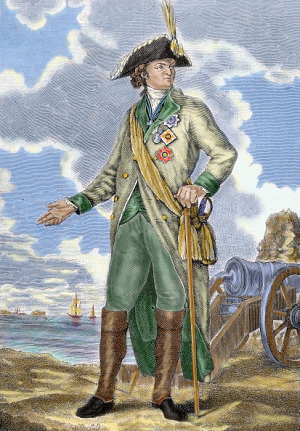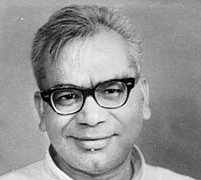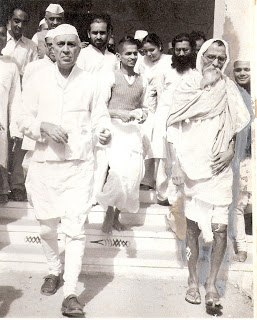Dec 17, 2025
Dec 17, 2025
by H.N. Bali
Continued from “Your Most Obedient Servant Gene”
Many Faces of Falsehood − V
Let me begin by telling you a story. It is about a village in Crimea, the much-conquered peninsula in the Republic of Ukraine located on the northern coast of the Black Sea. Crimea has the distinction of being often referred to with the definite article, as the Crimea for reasons I don’t know. However, before that a word or two about Potemkin. You may wonder how he fits in the context. Well, the tale I’m going to tell revolves around him.
Some of you will immediately associate the name Potemkin with that classic film of Sergey Eisenstein in which that great director immortalized the fictionalized version of the 1905 Russian Revolution. Yes, I’m referring to “Battleship Potemkin”. The warship was indeed named after the man I’m going to talk about.
Prince Potemkin
 Prince Grigory Potemkin was a Russian military leader, statesman, nobleman and, one of the favorites of Catherine the Great. He died when 52 in 1791 during negotiations over the Treaty of Jassy, which ended Russia’s war with the Ottoman Empire that he, had overseen.
Prince Grigory Potemkin was a Russian military leader, statesman, nobleman and, one of the favorites of Catherine the Great. He died when 52 in 1791 during negotiations over the Treaty of Jassy, which ended Russia’s war with the Ottoman Empire that he, had overseen.
He first attracted Catherine’s favor for helping in her 1762 coup, later distinguished himself as a military commander in the Russo-Turkish War (1768–1774). Catherine the Great had, like Her Majesty Queen Victoria in the next century, ample sexual appetite, liberally shared with quite a few lovers. (In case of Victoria one of them was an Indian − her Urdu tutor, the legendary Munshi Abdul Karim; about him some other day.)
Prince Grigory Potemkin became Catherine’s lover and some say even her consort for a while. After their passion cooled – as passions do − he remained her lifelong friend and favored statesman. Catherine obtained for him the title of Prince of the Holy Roman Empire and gave him the title of Prince of the Russian Empire among many others: he was both a Grand Admiral and the head of all of Russia’s land and irregular forces. Potemkin’s defining achievements include the peaceful annexation of the Crimea (1783) and the successful second Russo-Turkish War (1787–1792).
Potemkin founded several towns, including Sevastopol, which became the basis for his new Black Sea Fleet. A century after Potemkin’s death, his name was given to the Battleship Potemkin, which featured in the 1905 Russian Revolution and was fictionalized in “The Battleship Potemkin” by Sergey Eisenstein.
His rule in the south is associated with the “Potemkin village” on which hangs my story.
He once invited the Empress – so goes the story − to pay a royal visit to the famous Village. Now you know what happens when preparations start to welcome the royalty. All fictional method of ruse are deployed − construction of painted façades to mimic real villages, shown inhabited by happy, well-fed people, enthusiastically waving welcome banners for the visiting royalty. Potemkin loved pomp and pageantry as much he loved women and gambling. So, no trick of the trade was left out to build a mighty great impression. Hence, the phrase crept into the English language − Potemkin Village meaning an artificially decked up show erected just for the occasion.
The term Potemkin Village was coined by Georg von Helbig, the German biographer of Potemkin. After that, his critics accused Potemkin of using painted façades to fool Catherine into thinking that the area was far more prosperous than it actually was. Thousands of peasants were alleged to have been stage-managed for this purpose. Certainly, Potemkin had arranged for Catherine to see the best he had to offer (organizing numerous exotic excursions) and at least two cities’ officials did conceal poverty by building false houses. It is unlikely that the fraud approached the scale generally alleged. Modern historians are divided on the degree of truth behind the Potemkin village story.
Contemporary Potemkin Villages
After the original Potemkin Village there has been no looking back. Nazi Germany had, during the World War a concentration camp in Theresienstadt. It was called “the Paradise Ghetto”. It was designed as a concentration camp that could be shown to the Red Cross. Actually, it was a Potemkin village: attractive at first, but deceptive and ultimately lethal, with high death rates from malnutrition and contagious diseases. It ultimately served as a way-station to the notorious Auschwitz.
Democratic governments too indulge in this trick. In 1982, Mayor Ed Koch of New York City had the windows of abandoned buildings in the Bronx done up with decals of plants and Venetian blinds to hide the blight and the damage it had caused.
There were press reports that in preparation for hosting the July 2013 G8 summit in Enniskillen in Northern Ireland, in order to give the appearance of thriving businesses activity for visitors driving past them, all possible artificial devices were put up.
In the documentary “The Smartest Guys in the Room” on Enron’s trading floor, used to fool visiting analysts, is described as a “Potemkin Village”. Traders were thought to be engaged in dealing with outside clients, but were in fact conversing with people in the same building and each other. Imagine what they were really talking.
In The Geography of Nowhere, American writer James Kunstler refers to contemporary suburban shopping centers as “Potemkin village shopping plazas”. Imagine such a shopping plaza today in a derelict suburb of Detroit.
Indian Equivalents
If you want very Indian equivalents of the Potemkin Village, I can cite literally hundreds for you to choose from. Right now, just a few.
I used to work for an engineering company − now one of the Birla conglomerates, known as Texmaco, manufacturing textile machinery. In its Belgharia works, in north Kolkata, it had a pretty large Research Laboratory on the ground floor. As you took the flights of steps to go to the first floor which housed the main offices, you couldn’t help looking at the locked door of the Lab. It used to be swept clean with uniformed scientists working feverishly developing new processes on the day a VIP was visiting the plant. The next day the doors were again locked.
Here’s another gem. Accompanied by Nikolai Bulganin, Comrade Nikita Khrushchev decided to visit Kolkata during his historic visit to India in 1955. Remember what Lenin had said; the road to world revolution lies through Peking and Calcutta! (That’s how these two metropolises were spelled then.) The Government of West Bengal then headed by the legendary Dr. Bidhan Chandra Roy had a problem at hand. From the airport the Khrushchev cavalcade had to drive to Raj Bahvan. The route those days was BT Road. (Old Calcuttans, like me, will recall that there was then as yet no VIP Road connection from the airport to the town.) What to do about the ungainly sight of open drains en route? A substantial amount will be needed to cover the drains to show the town in a presentable light.
A very ingenious solution was thought of. Ask the bhadralok of the town to line up the roads on either side to ensure a welcome to the city that the Soviet leaders will remember for a long, long time. All the funds necessary were to provide free cha and bhiscoot, where necessary. And that did the trick. Lakhs and lakhs lined up the road − much to the utter delight of the distinguished visitors.
Rent-a-crowd
Today, such a trick is in fairly common use. It’s called in current political slang as window dressing. Half a century back, the yet-unnamed practice wasn’t in common use. Today, it is passé. Most of the crowds attending political meetings and rallies are brought in as part of rent-a-crowd technique. (The term rent-a-crowd is derived from a fictional company, Rentacrowd Ltd., mentioned in the Michael Wharton columns in the UK Daily Telegraph newspaper. Wharton, who died in 2006, wrote the column under the pen name Peter Simple.)
One of my journalist friends who knows Delhi and its goings-on for the last half a century like the back of his hand, tells me − and I haven’t the slightest reservation in buying his story − that the same crowd of hundred odd hirelings appeared in different dresses − one day as students of Delhi University, next day as tonga-wallhs of Delhi and the day after as mill workers − demanding that Indira Gandhi shouldn’t at all resign after the adverse Allahabad High Court judgment against her on June 12, 1973.
These are a few snippets chosen at random. Don’t forget there’s no society without its Potemkin Villages and professional window dressers whose services are in great demand to dress up things to suit the occasion.
Our Prized Potemkin Village
Take an important institution that over the years has made a notable contribution to sprout falsehood. That is the Planning Commission of India, a brainchild of Jawaharlal Nehru, started in March 1950. With unfailing regularity it has, over time, been coming out with elaborate data to justify its existence and the great progress India is making one five-year plan after another. Recently, P Sainath, the famous Hindu columnist proved how a rural Indian spending Rs. 22.50 a day would not be considered poor by the Commission whose Deputy Chairman, Dr. Mantek Singh Ahluwalia’s four global forays, covering 18 nights between May and October 2011, cost the exchequer a sum of Rs. 36,40,140, an average cost of Rs 2.02 lakh a day,”
Lately, Prof Utsa Patnaik of JNU in an article, “The dishonesty in counting the poor” in the columns of the Hindu, brought out how all official claims of low poverty level and poverty decline are quite spurious, solely the result of mistaken method. In reality, poverty is high and rising. By 2009-10, after meeting all essential non-food expenses (manufactured necessities, utilities, rent, transport, health, education), 75.5 per cent of rural persons could not consume enough food to give 2200 calories per day, while 73 per cent of all urban persons could not access 2100 calories.
The true estimation of poverty levels in India is an old controversy stretching back to the days of Jawaharlal who unfortunately had a penchant for diagnosing problems but was utterly ineffectual in finding solutions thereto. You may recall the famous “Teen Anna Pandrah Anna (3 annas − 15 annas)” controversy that Rammanohar Lohia stirred up in Parliament in 1963.
 For readers of this generation for which 1960’s are another age of the remote past, let me recount the facts. Lohia had written a pamphlet, “25,000 Rupees a Day”, the amount spent on Prime Minister Jawaharlal Nehru − an obscene sum in a country where the vast majority lived on 3 annas (less than one-quarter of a rupee) a day. (The much-in-decline Rupee once upon a time was made of sixteen annas.) Nehru demurred, maintaining that the Planning Commission statistics showed that the daily average income was more like 15 annas (a little under a rupee) per day. Lohia demanded that this was an important issue, one that cried out for a special debate. And a heated debate followed. (Again, today’s generation may be shocked to hear that in those days Parliament functioned and debated issues of national concern instead of shouting and howling and staging walk-outs.)
For readers of this generation for which 1960’s are another age of the remote past, let me recount the facts. Lohia had written a pamphlet, “25,000 Rupees a Day”, the amount spent on Prime Minister Jawaharlal Nehru − an obscene sum in a country where the vast majority lived on 3 annas (less than one-quarter of a rupee) a day. (The much-in-decline Rupee once upon a time was made of sixteen annas.) Nehru demurred, maintaining that the Planning Commission statistics showed that the daily average income was more like 15 annas (a little under a rupee) per day. Lohia demanded that this was an important issue, one that cried out for a special debate. And a heated debate followed. (Again, today’s generation may be shocked to hear that in those days Parliament functioned and debated issues of national concern instead of shouting and howling and staging walk-outs.)
During the debate Lohia built his case, demolishing the Planning Commission statistics as fanciful. It isn’t that the Planning Commission was deliberately attempting to mislead, but the reality was that a small number of rich people were pulling up the average to present a wholly unrealistic picture. At that time, Lohia’s figure was proved true for over 70% of the population. And the present reality is not far removed from that.
 May I mention a significant event which illustrates the irrelevance of most of the development plans initiated in the Capital of India? When the Planning Commission started its work on the First Five year Plan, Jawaharlal Nehru personally requested Acharya Vinoba Bhave to visit Delhi to help evolve the blueprint of India’s planned economic growth. On the Prime Minister’s persistent plea, Bhave, one on the last surviving Gandhians, attended a couple of Planning Commission meetings. The story goes − and this is not apocryphal − that after that he went back to Nehru to tell him that he was returning to Pavnar, Wardha. Asked by Nehru what prompted him to go back, Bhave is reported to have told the Prime Minister: “I attended the meetings but couldn’t make out which India they were talking of whose developments needs they planned to attend to.”
May I mention a significant event which illustrates the irrelevance of most of the development plans initiated in the Capital of India? When the Planning Commission started its work on the First Five year Plan, Jawaharlal Nehru personally requested Acharya Vinoba Bhave to visit Delhi to help evolve the blueprint of India’s planned economic growth. On the Prime Minister’s persistent plea, Bhave, one on the last surviving Gandhians, attended a couple of Planning Commission meetings. The story goes − and this is not apocryphal − that after that he went back to Nehru to tell him that he was returning to Pavnar, Wardha. Asked by Nehru what prompted him to go back, Bhave is reported to have told the Prime Minister: “I attended the meetings but couldn’t make out which India they were talking of whose developments needs they planned to attend to.”
There are several India’s indeed − the prospering India, the shining India, the striving India and the India of left-behinds. Bhave knew the last India, he knew it like the back of his hand − an India which is still, after six decades of planned development, represents what the Farsi word Pasmanda conveys i.e., the left behinds, the downtrodden: crushed, helpless, uncared, leading a sub-human existence on the fringes of our society. (I’ve purposely not described them by the highly politicized term dalit, which has connotations of the accursed caste system of Hindu society. Among pasmanda are included people of all religious labels.)
Continued to “Spin Doctors and the Myth of the Great Indian Economic Growth”
Image of Potemkin (c) Gettyimages.com
17-Aug-2013
More by : H.N. Bali

|
What can one say to you than thanks for your brilliant pieces that are enjoyable and enlightening in the same vein. In deed great passion and devotion to enrich the world of letters. |

|
Brilliant... |